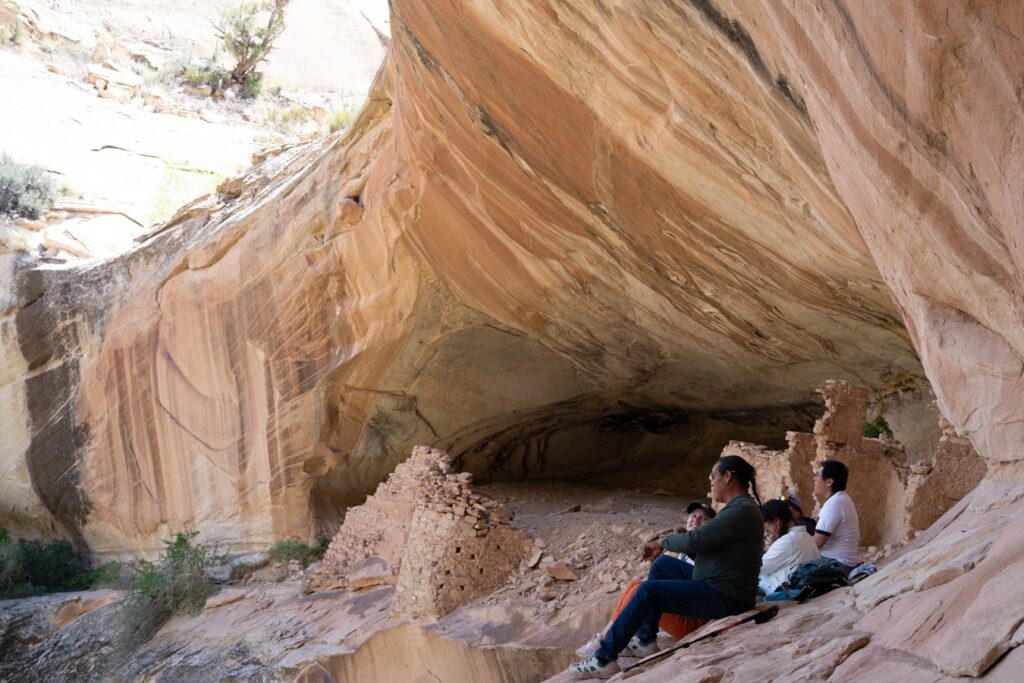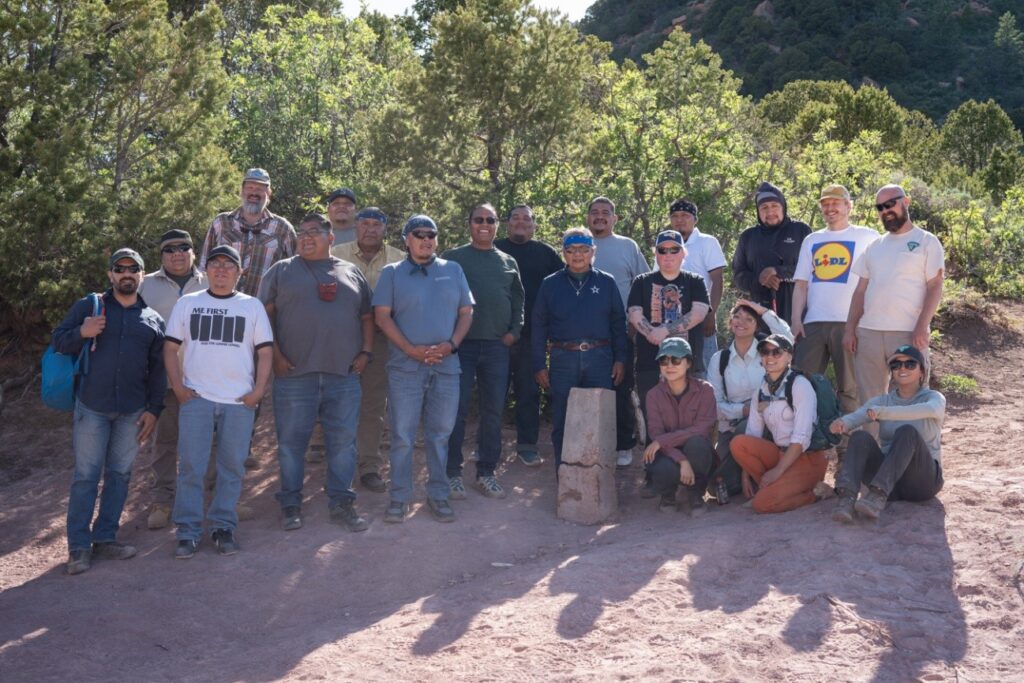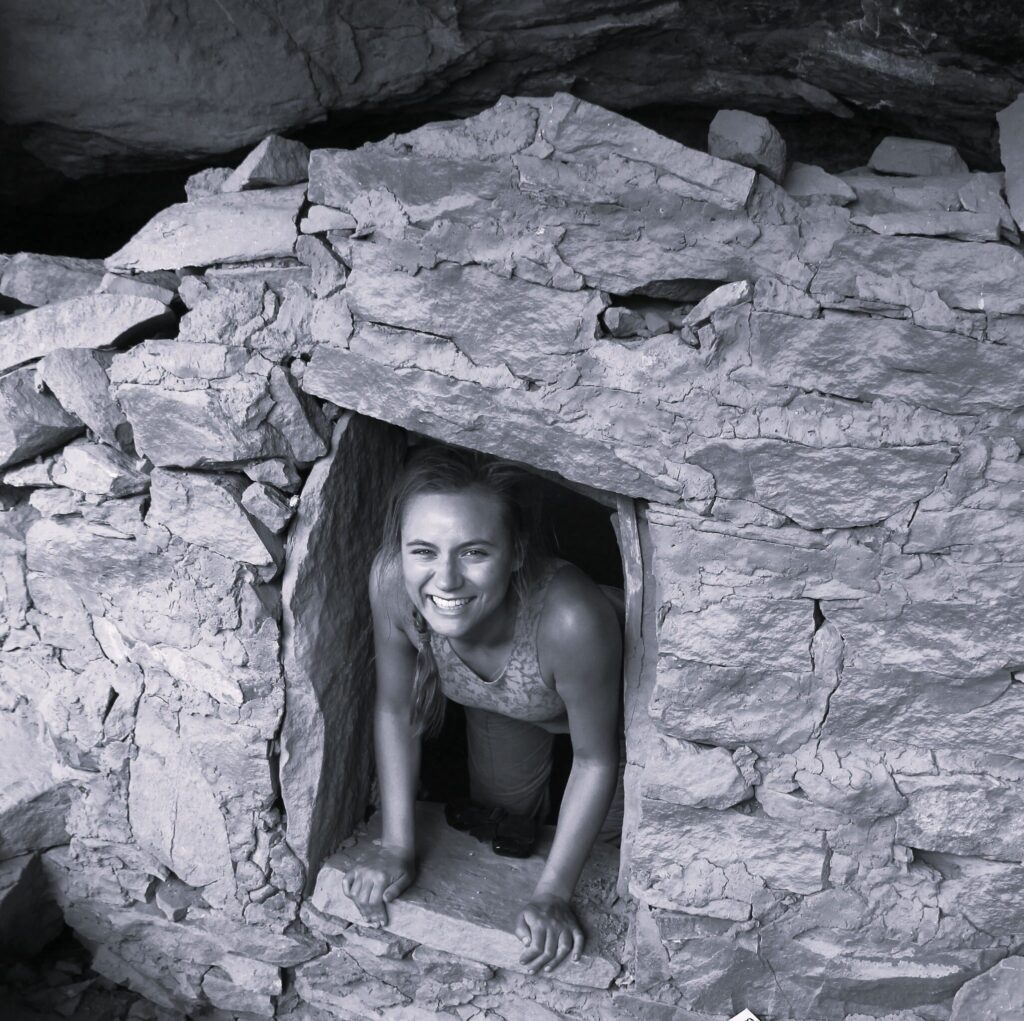My first week with Heritage Lands Collective, a non-profit organization dedicated to integrating Indigenous Knowledges (IK) into Tribal co-management of ancestral lands, was spent at the Bears Ears National Monument in southeast Utah. Bears Ears is the ancestral homelands of the Hopi, Ute, Navajo, Rio Grande Pueblos, and the Zuni. Joseph Gazing Wolf (Lakota/Amazigh/Nubian) and Director of Heritage Lands Collective is an expert in Tribal engagement; his projects address priorities in Indigenous communities from their inception, which requires “time to build relationships by educating yourself from the perspective of that community” and “giving your time, resources, and skill sets to serve community priorities” (Gazing Wolf et al. 2025:4).
Heritage Lands Collective practices ethnographic oral history methods that are rooted in IK. One technique they use is called yarning, which Luke Cantley, a social work researcher of the Gunditjmara Nation of Victoria, Australia, describes as a process of “listening and learning from others,” known as a “yarning circle” (Cantley 2024:133-134). Yarning is an act of deep listening that focuses on the thread of discussion the interviewee dictates, where storytelling is often used to articulate thoughts, feelings, and experiences that provide insights into cultural, familial, and communal values (Cantley 2024:141). Through asking questions that expand upon the interviewee’s story, a tapestry is woven that articulates the larger picture, resulting in data that is co-produced (Conversation with Joseph Gazing Wolf, June 12, 2025).
I had the privilege to practice this tradition as a place-based inquiry with the Heritage Lands Collective for Tribal engagement purposes. An in-situ interview within Bears Ears National Monument was possible because the project was grounded in the Tribe’s priorities and was scheduled according to the community’s existing engagements and events. This facet of community engagement is equally important in yarning because it demonstrates respect of the community’s ongoing responsibilities (see Cantley 2024:138; Gazing Wolf et al. 2024 and 2025).
–
An elder climbed to the alcove towards me. The sparkle in his eyes was possibly mistaken for tears of joy, a confirmation this place was sacred. I extended a bottle of water as he sat down. Together we were enveloped in stillness. The wind whistled and danced with the rustling of willows, cicada hums, and the soft laughter of friends and family. The cool, circular alcove offered protection from the torrid sun as the turquoise pool glittered its reflection. We smiled and I asked the first question, “Can you tell me about this place… Do your ancestors have stories or songs that this place reminds you of?”

Yarning created a conversation between me and the contributor that built a relationship grounded in trust, exemplified during the interview when he pointed one finger to his heart and the other to his forehead. This gesture highlights the accountability between me, as the researcher and a representative of Heritage Lands Collective, to share our data with the community, receive feedback, and include the Tribe’s interpretation of the meaning of the data (see also Cantley 2024:139). Heritage Lands’s purpose stems from translating the knowledge produced in this setting to elevate the community’s voice into co-management planning initiatives that exert the Tribe’s Rights.
Heritage Lands exemplifies productive research that prioritizes giving back to the community in a meaningful way. Tribal engagement and IK are rooted in kinship, a relationship that is grounded in familial relations to ancestral lands; and thus, requires reciprocal integration into every step of the research process.

With gratitude to all the communities that I’ve had the pleasure of learning from,
Carine
Note: Some researchers (see Cantley) have criticized the use of yarning by non-Indigenous researchers and specify yarning should be an invitation-only practice within Settler Colonial Institutions. Cantley’s point is critical within my own research, and I am appreciative of the invitation to practice this technique as part of Heritage Lands Collective.
Note from Director Joseph Gazing Wolf: Carine was invited to participate in this form of sacred research because she approached with humility, the willingness to learn, and a deep respect for Indigenous Peoples and their Knowledges; she is a model researcher.
For further questions contact Joseph Gazing Wolf at heritagelands@heritagelands.org.
Citations and Further Reading
Black Elk, Linda. 2016. Native Science: Understanding and Respecting Other Ways of Thinking, Rangelands, Volume 38, Issue 1, 2016, Pages 3-4, ISSN 0190-0528, https://doi.org/10.1016/j.rala.2015.11.003. (https://www.sciencedirect.com/science/article/pii/S0190052815001303)
Cantley, L. (2024). Indigenous Data Sovereignty: What Can Yarning Teach Us? Australian Social Work, 78(2), 133–144. https://doi.org/10.1080/0312407X.2024.2328169.
Gazing Wolf, J., Simmons, E., Blanchard, P., Jennings, L.L., Ignace, D.D., David-Chavez, D.M., Smiles, D., Montgomery, M., Plenty Sweetgrass-She Kills, R., Nelson, M.K., Doan-Crider, D., Black Elk, L., Black Elk, L., Bridge, G., Chischilly, A.M., Deer, K., DeerinWater, K., Ecoffey, T., Vergun, J., Wildcat, D. and Rattling Leaf, J. (2025), A path to Reconciliation Between Indigenous and Settler–Colonial Epistemologies. Frontiers in Ecology and the Environment e2847. https://doi-org.yale.idm.oclc.org/10.1002/fee.2847.
Gazing Wolf, J., Ignace, D.D., David-Chavez, D.M., Jennings, L.L., Smiles, D., Blanchard, P., Simmons, E., Doan-Crider, D., Kills, R.P.S.-S., Montgomery, M., Nelson, M.K., Black Elk, L., Black Elk, L., Bridge, G., Chischilly, A.M., Deer, K., DeerinWater, K., Ecoffey, T., Vergun, J., Wildcat, D. and Rattling Leaf, J. (2024), Centering Indigenous Knowledges in Ecology and Beyond. Frontiers in Ecology and the Environment, 22: e2776. https://doi-org.yale.idm.oclc.org/10.1002/fee.2776.
Gazing Wolf, J. 2024. Relational Engagement with Indigenous Communities through the Heritage Lands Collective. Archeology Podcast Network. www.archaeologypodcastnetwork.com/heritagevoices/86?ms+sat_email&utm_campaign=sat&utm_medium=email&utm=aswemail&emci=a82c0b99-b118-ef11-86d0-6045bdd9e096&emdi=9af3a58a-1d19-ef11-86d0-6045bdd9e09&ceid=12554. Viewed 30 June 2025.
Wall Kimmerer, Robin. “Renewing Relationships Between Land and Culture.” Traditional Knowledge and Bears Ears, Bears-Ears Inter-Tribal Coalition. Accessed 30 June 2025. https://www.bearsearscoalition.org/traditional-knowledge-and-bears-ears/.
“What We Do.” Heritage Lands Collective, https://heritagelands.org/what-we-do#:~:text=Heritage%20Lands%20Collective%20is%20an,communities%20to%20their%20ancestral%20homelands.
STUDENT RESEARCHER

Carine Rofshus – Western Resource Fellow | Carine is a Master’s in Environmental Science Candidate at the Yale School of Environment. Her research focuses on the integration of Traditional Ecological Knowledge and cultural resources stewardship through working with Indigenous communities in the U.S. Southwest. She is particularly interested in the relationship between traditional ceramics processes and the environment as place-making practices. Carine currently serves as a NAGPRA (Native American Graves Protection and Reparation Act) Assistant for the Yale Peabody Museum. Prior to Yale, Carine worked as an archaeologist for a native-women-owned small business dedicated to hazardous waste clean-up on Tribal, Federal, and Department of Defense lands. She has extensive experience on the Navajo Nation in addition to Arizona, Colorado, Guam, New Mexico, and Utah. Carine is a former National Park Service Cultural Interpretation volunteer for the Gila Cliff Dwellings National Monument. She holds a BA in Art History from St. Olaf College and attended the Crow Canyon Archaeological Center Field School as a National Science Foundation Fellow. In her free time, she enjoys backpacking, figure skating, and watercolor painting. See what Carine has been up to.
